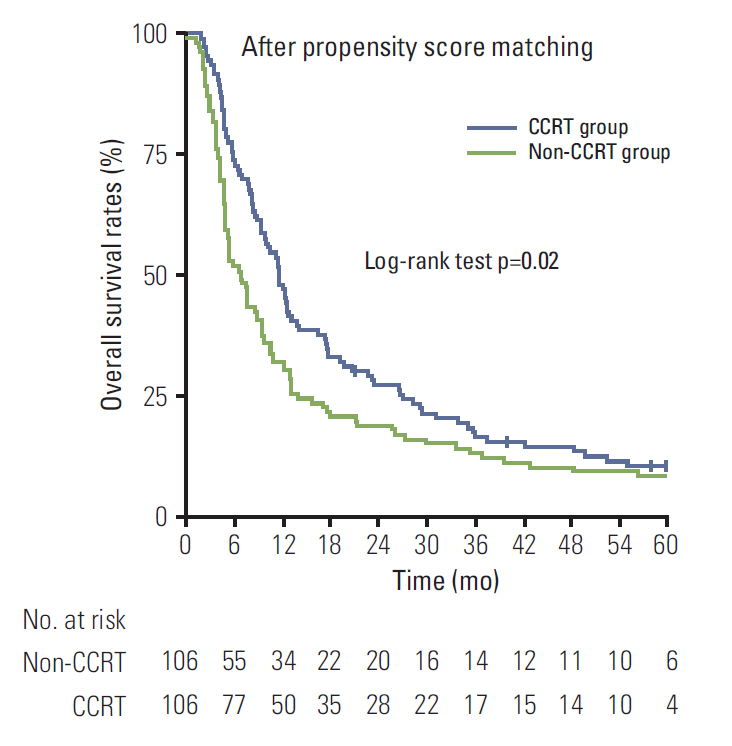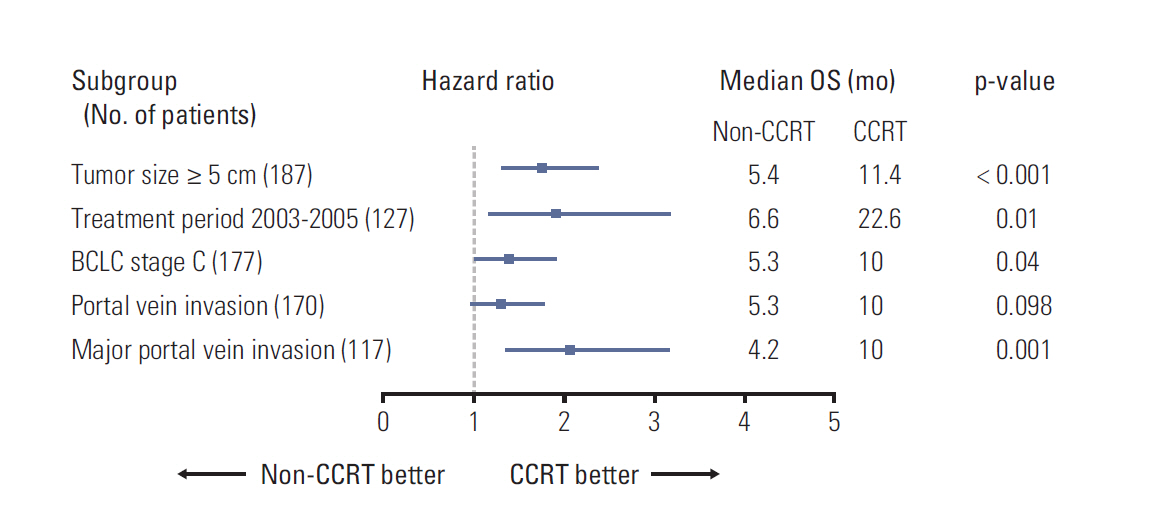Cancer Res Treat.
2016 Jan;48(1):190-197. 10.4143/crt.2014.276.
Clinical Benefit of Hepatic Arterial Infusion Concurrent Chemoradiotherapy in Locally Advanced Hepatocellular Carcinoma: A Propensity Score Matching Analysis
- Affiliations
-
- 1Department of Radiation Oncology, Yonsei Cancer Center, Yonsei University College of Medicine, Seoul, Korea. jsseong@yuhs.ac
- 2Department of Pharmacology, Brain Korea 21 Plus Project for Medical Science, Yonsei University College of Medicine, Seoul, Korea.
- 3Department of Biostatics, Yonsei University College of Medicine, Seoul, Korea.
- 4Yonsei Liver Cancer Special Clinic, Yonsei University College of Medicine, Seoul, Korea.
- 5Korean Liver Cancer Study Group, Seoul, Korea.
- 6Department of Internal Medicine, Yonsei University College of Medicine, Seoul, Korea.
- KMID: 2152275
- DOI: http://doi.org/10.4143/crt.2014.276
Abstract
- PURPOSE
The aim of this study was to evaluate whether hepatic arterial infusion concurrent chemoradiotherapy (CCRT) could improve overall survival (OS) in patients with locally advanced hepatocellular carcinoma (LAHCC).
MATERIALS AND METHODS
Two databases were reviewed from Yonsei Cancer Center (YCC) and Korean Liver Cancer Study Group (KLCSG) nationwide multi-center hepatocellular carcinoma (HCC) cohort. The CCRT group included 106 patients, with stage III-IV, Child-Pugh classification A, Eastern Cooperative Oncology Group performance status 0 or 1, who underwent definitive CCRT as the initial treatment at YCC. We used propensity score matching to adjust for seven clinical factors, including age, tumor size, TNM stage by the Liver Cancer Study Group of Japan, T stage, Barcelona Clinic Liver Cancer (BCLC) staging system, etiology of HCC, and portal vein invasion, which all differed significantly in the two databases. From the KLCSG cohort enrolled at 32 institutions, 106 patients for the non-CCRT group were defined.
RESULTS
After propensity score matching, all patient characteristics were balanced between the two groups. The CCRT group had better OS (median, 11.4) than the non-CCRT group (6.6 months, p=0.02). In multivariate analyses for all patients, CCRT (hazard ratio [HR], 1.48; 95% confidence interval [CI], 1.11 to 1.97; p=0.007), tumor size (HR, 1.08; 95% CI, 1.04 to 1.12; p < 0.001), and BCLC stage (HR, 0.54; 95% CI, 0.36 to 0.8; p=0.003) were independent prognostic factors for OS.
CONCLUSION
CCRT showed better OS for LAHCC patients. In LAHCC patients with a good performance and normal liver function, CCRT could be a feasible treatment option. All of these findings need to be validated in prospective clinical trials.
MeSH Terms
Figure
Reference
-
References
1. Parkin DM, Bray F, Ferlay J, Pisani P. Global cancer statistics, 2002. CA Cancer J Clin. 2005; 55:74–108.
Article2. Bruix J, Sherman M; American Association for the Study of Liver Diseases. Management of hepatocellular carcinoma: an update. Hepatology. 2011; 53:1020–2.
Article3. Fleissig A, Jenkins V, Catt S, Fallowfield L. Multidisciplinary teams in cancer care: are they effective in the UK? Lancet Oncol. 2006; 7:935–43.
Article4. Fennell ML, Das IP, Clauser S, Petrelli N, Salner A. The organization of multidisciplinary care teams: modeling internal and external influences on cancer care quality. J Natl Cancer Inst Monogr. 2010; 2010:72–80.
Article5. Zaorsky NG, Trabulsi EJ, Lin J, Den RB. Multimodality therapy for patients with high-risk prostate cancer: current status and future directions. Semin Oncol. 2013; 40:308–21.
Article6. Hadziahmetovic M, Shirai K, Chakravarti A. Recent advancements in multimodality treatment of gliomas. Future Oncol. 2011; 7:1169–83.
Article7. Stillwagon GB, Order SE, Guse C, Klein JL, Leichner PK, Leibel SA, et al. 194 hepatocellular cancers treated by radiation and chemotherapy combinations: toxicity and response: a Radiation Therapy Oncology Group Study. Int J Radiat Oncol Biol Phys. 1989; 17:1223–9.
Article8. Mornex F, Girard N, Beziat C, Kubas A, Khodri M, Trepo C, et al. Feasibility and efficacy of high-dose three-dimensional-conformal radiotherapy in cirrhotic patients with small-size hepatocellular carcinoma non-eligible for curative therapies--mature results of the French Phase II RTF-1 trial. Int J Radiat Oncol Biol Phys. 2006; 66:1152–8.
Article9. Seong J, Lee IJ, Shim SJ, Lim DH, Kim TH, Kim JH, et al. A multicenter retrospective cohort study of practice patterns and clinical outcome on radiotherapy for hepatocellular carcinoma in Korea. Liver Int. 2009; 29:147–52.
Article10. Yoon HI, Lee IJ, Han KH, Seong J. Improved oncologic outcomes with image-guided intensity-modulated radiation therapy using helical tomotherapy in locally advanced hepatocellular carcinoma. J Cancer Res Clin Oncol. 2014; 140:1595–605.
Article11. National Comprehesive Cancer Network. NCCN clinical practice guidelines in oncology, hepatobiliary cancers [Internet]. Fort Washington, MD: National Comprehensive Cancer Network;2014. [cited 2015 Jan 2]. Available from: http://www.nccn.org/professionals/physician_gls/pdf/hepatobiliary.pdf.12. Han KH, Seong J, Kim JK, Ahn SH, Lee DY, Chon CY. Pilot clinical trial of localized concurrent chemoradiation therapy for locally advanced hepatocellular carcinoma with portal vein thrombosis. Cancer. 2008; 113:995–1003.
Article13. Park MS, Kim SU, Park JY, Kim DY, Ahn SH, Han KH, et al. Combination treatment of localized concurrent chemoradiation therapy and transarterial chemoembolization in locally advanced hepatocellular carcinoma with intrahepatic metastasis. Cancer Chemother Pharmacol. 2013; 71:165–73.
Article14. Ben-Josef E, Normolle D, Ensminger WD, Walker S, Tatro D, Ten Haken RK, et al. Phase II trial of high-dose conformal radiation therapy with concurrent hepatic artery floxuridine for unresectable intrahepatic malignancies. J Clin Oncol. 2005; 23:8739–47.
Article15. Korean Liver Cancer Study Group. Report of randomized registration for hepatocellular carcinoma in Korea [Internet]. Seoul: Korean Liver Cancer Study Group;2010. [cited 2015 Jan 1]. Available from: http://klcsg.or.kr/.16. von Elm E, Altman DG, Egger M, Pocock SJ, Gotzsche PC, Vandenbroucke JP, et al. The Strengthening the Reporting of Observational Studies in Epidemiology (STROBE) statement: guidelines for reporting observational studies. Lancet. 2007; 370:1453–7.
Article17. Liver Cancer Study Group of Japan. The general rules for the clinical and pathological study of primary liver cancer. 4th ed. Tokyo: Kanehara Co. Ltd.;2000.18. Park JW; Korean Liver Cancer Study Group and National Cancer Center. Practice guideline for diagnosis and treatment of hepatocellular carcinoma. Korean J Hepatol. 2004; 10:88–98.19. Llovet JM, Ricci S, Mazzaferro V, Hilgard P, Gane E, Blanc JF, et al. Sorafenib in advanced hepatocellular carcinoma. N Engl J Med. 2008; 359:378–90.
Article20. Cheng AL, Kang YK, Chen Z, Tsao CJ, Qin S, Kim JS, et al. Efficacy and safety of sorafenib in patients in the Asia-Pacific region with advanced hepatocellular carcinoma: a phase III randomised, double-blind, placebo-controlled trial. Lancet Oncol. 2009; 10:25–34.
Article21. Yoon SM, Lim YS, Won HJ, Kim JH, Kim KM, Lee HC, et al. Radiotherapy plus transarterial chemoembolization for hepatocellular carcinoma invading the portal vein: long-term patient outcomes. Int J Radiat Oncol Biol Phys. 2012; 82:2004–11.
Article22. Yamada K, Izaki K, Sugimoto K, Mayahara H, Morita Y, Yoden E, et al. Prospective trial of combined transcatheter arterial chemoembolization and three-dimensional conformal radiotherapy for portal vein tumor thrombus in patients with unresectable hepatocellular carcinoma. Int J Radiat Oncol Biol Phys. 2003; 57:113–9.
Article23. Dawson LA, McGinn CJ, Normolle D, Ten Haken RK, Walker S, Ensminger W, et al. Escalated focal liver radiation and concurrent hepatic artery fluorodeoxyuridine for unresectable intrahepatic malignancies. J Clin Oncol. 2000; 18:2210–8.
Article24. Kim KH, Kim MS, Chang JS, Han KH, Kim DY, Seong J. Therapeutic benefit of radiotherapy in huge (>/=10 cm) unresectable hepatocellular carcinoma. Liver Int. 2014; 34:784–94.25. Lee HS, Choi GH, Choi JS, Kim KS, Han KH, Seong J, et al. Surgical resection after down-staging of locally advanced hepatocellular carcinoma by localized concurrent chemoradiotherapy. Ann Surg Oncol. 2014; 21:3646–53.
Article
- Full Text Links
- Actions
-
Cited
- CITED
-
- Close
- Share
- Similar articles
-
- A Case of Concurrent Chemoradiation Therapy for Locally Advanced Hepatocellular Carcinoma with Portal Vein Thrombosis
- A Case of Hepatocellular Carcinoma with Portal Vein Tumor Thrombosis Treated by Hepatic Artery Injection Chemotherapy and Radiotherapy
- Long-term survival after CCRT and HAIC followed by ALPPS for hepatocellular carcinoma with portal vein invasion: a case report
- Hepatic arterial infusion chemotherapy for advanced hepatocellular carcinoma in the era of chemo-diversity
- Efficacy of Hepatic Arterial Infusion Chemotherapy and Radiofrequency Ablation against Hepatocellular Carcinoma Refractory to Transarterial Chemoembolization and Vascular Variation: A Case Study



